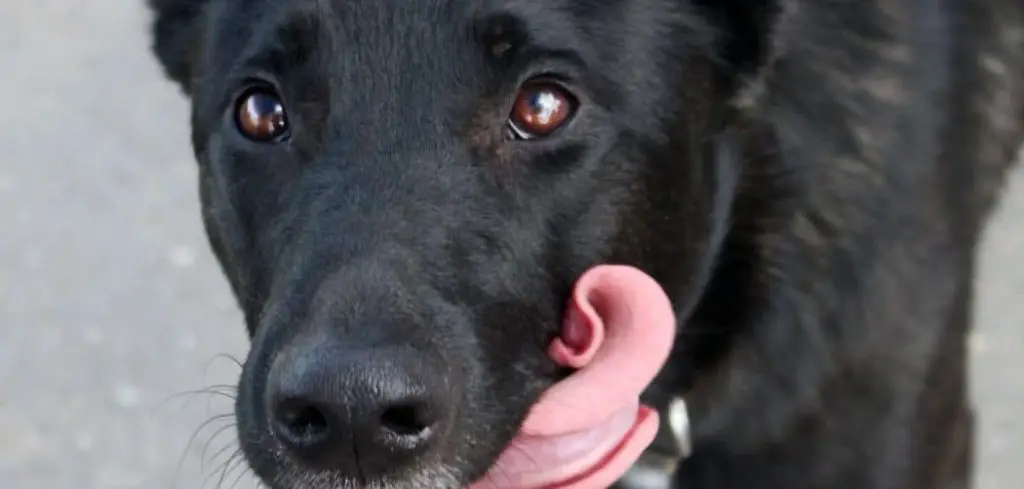A dog excessively licking fabric may seem quirky at first, but it can point to behavioral, medical, or dietary issues that need attention.
From boredom and anxiety to digestive discomfort or nutritional imbalances, this repetitive behavior is often more than just a harmless habit.
We outline the common reasons for excessive fabric licking in dogs, what you can do at home, and when to seek veterinary help.
Dog Excessively Licking Fabric — Why It Happens
Dogs may lick fabric excessively because of stress, boredom, or compulsive behaviors, but sometimes the cause is medical, such as nausea, dental pain, or nutritional deficiencies.
While some dogs lick blankets or clothes for comfort, others may be signaling anxiety, gastrointestinal upset, or even neurological conditions.
It’s important to pay attention to when and how often your dog licks fabric, since that context can reveal whether the cause is more behavioral or physical.

Dog Excessively Licking Fabric: Common Causes
Anxiety or Stress
Many dogs turn to repetitive behaviors like licking fabric when they feel anxious or stressed. This can be triggered by loud noises, separation from owners, or changes in routine.
Licking provides self-soothing by releasing endorphins, which temporarily calms your dog.
However, excessive licking that continues daily may indicate chronic anxiety that needs behavioral training or support.
Read more: Dog Excessively Licking Couch (Causes explained)
Boredom or Habit
Fabric licking can also stem from simple boredom, especially in dogs that lack enough physical exercise or mental stimulation.
Chewing and licking give dogs an outlet when they don’t have toys, play, or interaction. Over time, this can develop into a habit, making the behavior harder to break.
Dogs left alone for long periods are particularly prone to forming this type of compulsive routine.
Gastrointestinal Upset
Digestive issues like nausea, acid reflux, or an upset stomach can also drive dogs to lick fabric excessively.
The action may help soothe discomfort or serve as an instinctive response to nausea.
You might notice additional symptoms such as drooling, grass eating, vomiting, or changes in appetite. If fabric licking appears alongside digestive signs, a medical cause is more likely.
Nutritional Deficiencies
Sometimes, dogs lick unusual objects like fabric because they’re lacking certain nutrients or minerals.
This behavior, known as pica, can extend to licking or eating dirt, rocks, or other non-food items. A poor diet or malabsorption condition could lead to these cravings.
In these cases, simply redirecting the behavior won’t work until the underlying nutritional issue is addressed.
Dental Pain or Oral Issues
Tooth pain, gum disease, or oral injuries can cause unusual licking behaviors in dogs. Instead of chewing toys or bones, some dogs may lick fabric because it feels soothing against their mouth.
If your dog is licking fabric excessively along with bad breath, pawing at the mouth, or difficulty eating, a dental exam is recommended.
Compulsive Behavior Disorder
In some cases, fabric licking is part of a compulsive disorder, similar to obsessive-compulsive tendencies in people.
These dogs may lick relentlessly, regardless of distractions, food, or training. Compulsive licking often develops when stress, boredom, or anxiety go unaddressed for long periods, and it can become ingrained even after the trigger is gone.
Veterinary guidance is needed to manage compulsive behaviors before they worsen.
What to Do If Your Dog Is Excessively Licking Fabric
If your dog is licking fabric more than occasionally, the first step is to assess their environment and health.
Ensure they’re getting enough daily exercise, play, and mental stimulation to reduce boredom-driven licking. Interactive toys, puzzle feeders, and regular walks can help redirect their energy.
Check your dog’s overall health for signs of nausea, dental pain, or nutritional concerns. Keeping them on a balanced, vet-approved diet is key to avoiding deficiencies that drive abnormal licking.
If you suspect digestive issues, monitor for vomiting, appetite loss, or grass eating, and share these details with your vet.
It’s also helpful to provide safe alternatives for licking, such as chew toys, frozen treats, or lick mats.
These give your dog the same soothing satisfaction without damaging your clothes or furniture. For anxious dogs, calming aids, routine stability, and gradual desensitization can reduce stress-related licking.
Related: Dog licking excessively (Explained)
When to Call or Visit Your Vet
Occasional fabric licking isn’t always cause for alarm, but excessive or obsessive licking should be taken seriously.
Veterinary evaluation is especially important if the behavior appears suddenly, escalates quickly, or is paired with other symptoms.
Call your vet if you notice vomiting, diarrhea, drooling, or loss of appetite alongside fabric licking, as these may indicate gastrointestinal illness.
If your dog also shows signs of oral discomfort, such as difficulty chewing or pawing at the mouth, dental disease could be the root cause.
Seek help if the behavior persists despite increased exercise, stimulation, and redirection. Compulsive licking won’t improve on its own and can lead to ingestion of fibers that cause blockages.
A vet can rule out medical causes and may recommend behavioral therapy or medication if the problem is linked to anxiety or compulsive disorder.
Read more: Dog Excessively Licking Kitchen Floor (When to worry)
Key Takeaway
Excessive fabric licking in dogs can be a sign of anxiety, boredom, medical issues, or even compulsive behavior.
While some cases may improve with more stimulation and redirection, others require veterinary evaluation to rule out digestive problems, nutritional deficiencies, or dental pain.
Paying attention to your dog’s overall health and behavior is the best way to know whether this quirky habit is harmless or a signal for help.
